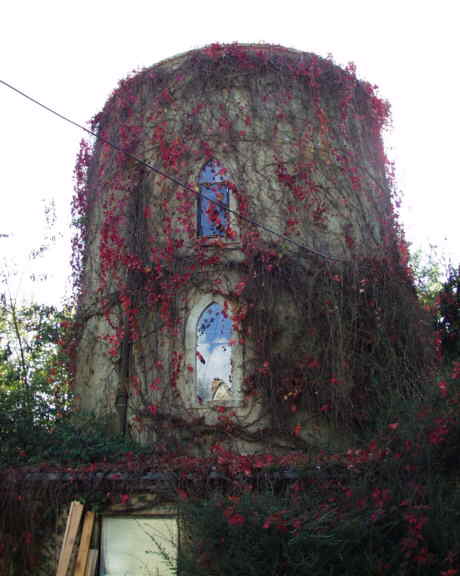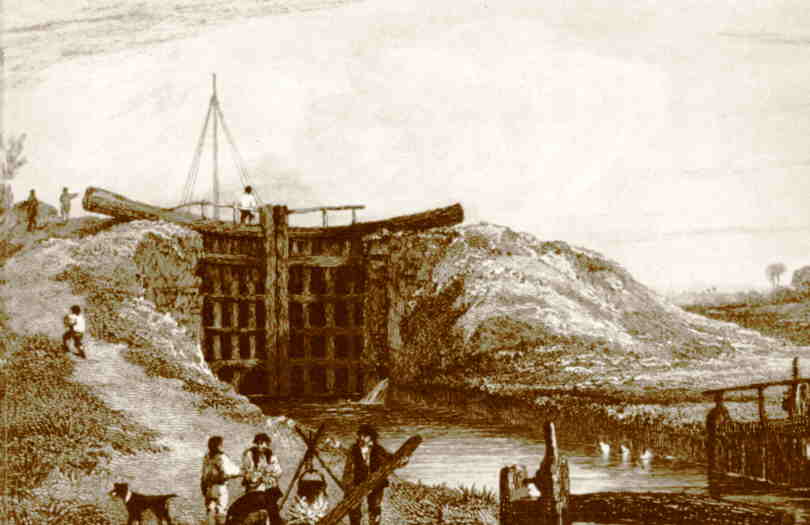Inglesham & Dudgrove
Picture Gallery
Back to T&S Canal
Page
Inglesham
Inglesham, just east of Lechlade, is the place where the Thames and
Severn Canal made its junction with the River Thames. It was also the
last part of the canal to be built during 1789.
 Next to the lock is one of the famous T&S Canal roundhouses. It
is the last of the 3 which had inverted conical roofs to substantially retain
the original roof structure. Rain falling on the roof was channelled to
a lead collecting bowl in the centre which was connected to a cistern which
stored water for drinking purposes (there was less awareness problems of
lead poisoning in those days). The roundhouse was probably built
in 1790, just after the canal opened.
Next to the lock is one of the famous T&S Canal roundhouses. It
is the last of the 3 which had inverted conical roofs to substantially retain
the original roof structure. Rain falling on the roof was channelled to
a lead collecting bowl in the centre which was connected to a cistern which
stored water for drinking purposes (there was less awareness problems of
lead poisoning in those days). The roundhouse was probably built
in 1790, just after the canal opened.
Just downstream of the lock and bridge, there is a small warehouse
building - now a dwelling. Its remote location and poor road access meant
that, by 1813, the T&S Canal company felt it necessary to buy the pre-existing
Parkend Wharf in Lechlade as a more practical alternative
Inglesham Lock is still has its original 90ft length, there being no
real shortage of water in this part of the canal. The rather pleasant
stone bridge at its tail has the date 14th November 1789 inscribed on
it - and the first boat passed through the whole length of the canal just
5 days later.
There is some evidence that the lock had a circular overflow weir on
the roundhouse side of the lock judging by the presence of a circular
hedge nearby. There certainly was an overflow weir somewhere as the last
pair of top gates to be installed, which at the time of writing still survive
in situ, were planked right up to the balance beams.
The lock here has a fall of only 6ft 2in but may have originally been
intended to have a 9ft fall to match that of the conventional upper part
of Dudgrove Double Lock. This last part of the canal was started very late
in the project and it may simply have been the case that the canal builders
found that they would have had to import a lot of additional material to
build the slight embankment to maintain equal falls - but not until after
they had already built the upper chamber at Dudgrove. Another theory is
that the Proprietors were expecting to extend the canal eastwards to Abingdon
to bypass the upper part of the Thames. If this was the case, crossing the
Thames at anything other than on the level would have proved an interesting
problem as a right of navigation did, and still does, exist on the Thames
to Cricklade. Thus a low headroom aqueduct would not have been permitted
and the higher level of the canal which would have been caused by the
omission of the lower chamber at Dudgrove would not have made much difference.
Immediately above Inglesham Lock was a large enough basin to allow
90ft boats to turn and thus avoid entry into the Thames.
Dudgrove Double Lock
Dudgrove Double Lock is one of the strangest structures on the T&S
Canal. Its top chamber is identical in design to many of the other T&S
locks being of mainly brick construction with stone quoins. There is even
an overflow weir outlet in the wall below the middle gates. Its fall is
similar to those at Siddington, South Cerney and Latton.
The bottom chamber is very different and has all the feeling of an
afterthought. Its about 135ft long and 27 ft wide. The bottom gates are
situated in brick narrows of the normal width but the rest of the chamber
walls are of dry stone.
At the time of writing, the lower and middle gates are still in situ
and one of the middle gates is more or less complete with paddle gear
and balance beam in place - it will even open and close but is now getting
very fragile with age. The upper gates have at some point in the past been
replaced by a low concrete wall but due to the infilling of the canal bed
upstream, water no longer comes down this part of the canal and the upper
paddles are not longer in place although until recently, one of the top
ground paddle racks was still there.
This lock is very overgrown and therefore difficult to photograph but
remains one of the most complete T&S locks with much of its timber work
still in place. Its remote location on private land has largely been responsible
for this.

To the left is an old engraving dating from 1814 showing Dudgrove Double
Lock in operation but its technical accuracy leaves much to be desired.
Picture Gallery
Back to T&S Canal Page
Copyright
© Ken Burgin 2002 - all rights reserved
 Next to the lock is one of the famous T&S Canal roundhouses. It
is the last of the 3 which had inverted conical roofs to substantially retain
the original roof structure. Rain falling on the roof was channelled to
a lead collecting bowl in the centre which was connected to a cistern which
stored water for drinking purposes (there was less awareness problems of
lead poisoning in those days). The roundhouse was probably built
in 1790, just after the canal opened.
Next to the lock is one of the famous T&S Canal roundhouses. It
is the last of the 3 which had inverted conical roofs to substantially retain
the original roof structure. Rain falling on the roof was channelled to
a lead collecting bowl in the centre which was connected to a cistern which
stored water for drinking purposes (there was less awareness problems of
lead poisoning in those days). The roundhouse was probably built
in 1790, just after the canal opened. 